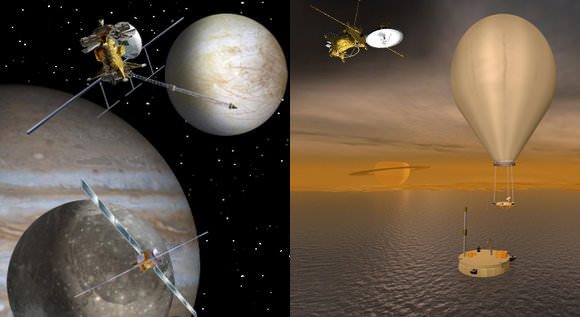[/caption] At a meeting last week between NASA and ESA, the two space agencies narrowed down the choices for the next big flagship planetary missons, which will be joint efforts between the US and Europe. A mission to Jupiter and its four largest moons will be the primary mission the two space agencies will focus on, while they continue to plan for another potential mission to visit Saturn's largest moon Titan and Enceladus. The two missions, the Jupiter System Mission and the Titan Saturn System Mission, are the result of NASA and ESA merging their separate mission concepts.
"This joint endeavour is a wonderful new exploration challenge and will be a landmark of 21st Century planetary science," said David Southwood, ESA Director of Science and Robotic Exploration. "What I am especially sure of is that the cooperation across the Atlantic that we have had so far and we see in the future, between America and Europe, NASA and ESA, and in our respective science communities is absolutely right. Let's get to work."
The Europa Jupiter System Mission would use two robotic orbiters to conduct detailed studies of the giant gaseous planet Jupiter and its moons Io, Europa, Ganymede and Callisto. NASA would build one orbiter, initially named Jupiter Europa. ESA would build the other orbiter, initially named Jupiter Ganymede. The probes would launch in 2020 on two separate launch vehicles from different launch sites. The orbiters would reach the Jupiter system in 2026 and spend at least three years conducting research. [caption id="attachment_25809" align="aligncenter" width="249" caption="Europa. Credit: NASA"]
[/caption] Europa has a surface of ice, and scientists theorize it has an ocean of water beneath that could provide a home for living things. Ganymede, the largest moon in the solar system, is the only moon known to have its own internally generated magnetic field and is suspected to have a deep undersurface water ocean. Scientists long have sought to understand the causes of the magnetic field. Callisto's surface is extremely heavily cratered and ancient, providing a clear indication of a record of events from the early history of the Solar System. Finally, Io is the most volcanically active body in the solar system.
"The decision means a win, win situation for all parties involved," said Ed Weiler, associate administrator for NASA's Science Mission Directorate in Washington. "Although the Jupiter system mission has been chosen to proceed to an earlier flight opportunity, a Saturn system mission clearly remains a high priority for the science community."
The future Titan Saturn System Mission would consist of a NASA orbiter and an ESA lander and research balloon.
Both of these proposed missions will set the stage for future planetary science research. These outer planet flagship missions could eventually answer questions about how our solar system formed and whether life exists elsewhere in the universe.
Source:
JPL
 Universe Today
Universe Today
